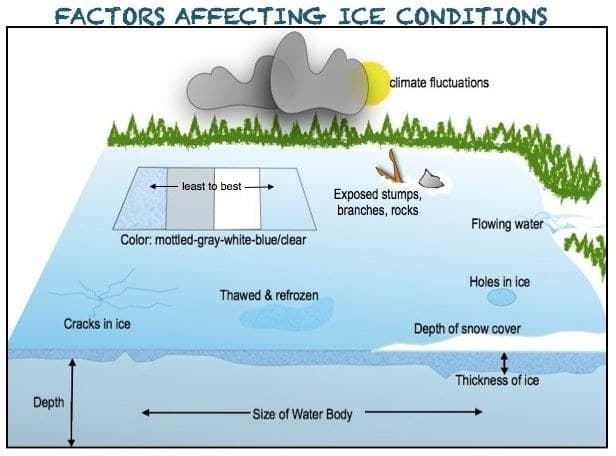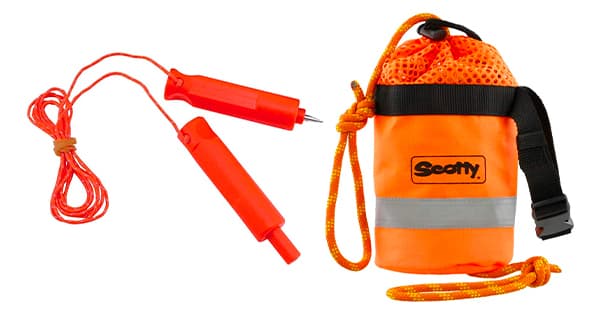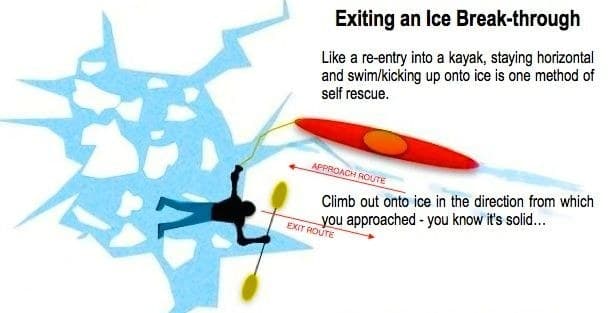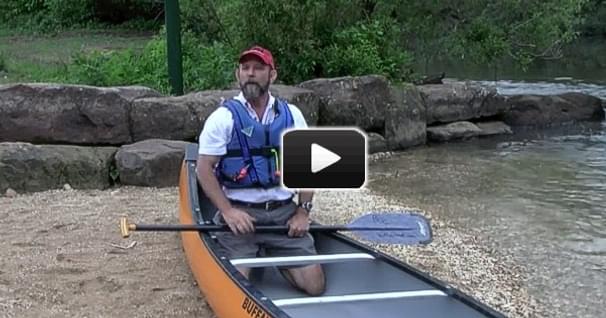Surviving On Icy Waters
"The noise resembles the roar of heavy, distant surf.
Standing on the stirring ice one can imagine it is disturbed
by the breathing and tossing of a mighty giant below."
- Ernest Shackleton
Padding in the winter is as potentially hazardous as it is exhilarating. Both saltwater and freshwater paddlers have their own array of yellow flags to contend with when venturing out onto ice-laden waters. Not all our encounters with frozen surfaces may be while in our boats. We may be forced to drag a kayak across a stretch of ice or slide a canoe over a frozen section of river. If we have no option to avoid ice, we can turn back or tenderly advance forward. Knowing what to look for and what to do if we fall through are critical aspects of ice paddling safety.
Factors that Affect Ice
Ice has multiple personalities - many factors affect the kind of ice one might encounter. They include:
- Overall weather conditions when ice was formed or affecting it since formation
- Depth of snow that insulates ice during initial formation or afterwards
- Inflow of water that weakens ice structure
- Contaminants that affect solidity of ice
- Protruding rocks, branches, etc. that absorb heat and affect adjacent ice
- Holes and re-melts that weaken ice
- The depth of water over which ice was formed (to support ice layer)
- Expanse/Extent of body of water
- Vertical cracks, particularly those that go all the way through the ice and have right-angle intersecting cracks.
Ice color can also be an indication of ice integrity. Blue or clear ice is usually the strongest; black, white or mottled ice usually means contaminants or air bubbles that weaken the ice. Solid, strong ice also makes a "tick" sound when struck by a metal object (tip of a ski pole, for example). A "tock" or dull sound indicates ice with air holes or other weakening features. Your safest bet with ice is to NOT go out on it. If you must travel across ice, knowing how to read it is your second best method of staying safe.

50 years of lightweight, maneuverable, high-performing kayaks.
Check out this interview with Tom Keane, Eddyline Kayaks Co-Owner, on their journey!
What to do if You Fall Through Ice
So what happens if you do fall through the ice? There have been extensive field studies where researchers have taken the frigid plunge to find out what really happens to the human body and what rescue techniques work the best. The U.S. Swim School Association and others offer tips on what happens and what to do should find yourself in this life-threatening situation.
- Quickly brace yourself for the shock of the cold plunge. This is critical because the second step is…
- Stay calm! Right, like that's going to happen. Seriously, the biggest factor in ice fall deaths is the Cold Shock Response (CSR). That's gasping for air and getting cold water into your lungs - that means you drown! CSR typically lasts only a few minutes. If you can stay somewhat calm, you can then be in a better situation to rescue yourself.
- Position yourself for rescue by facing back to the direction from which you approached this weak ice. You know the ice is good in that direction, you don't know how strong/safe it is in others. Get out from the side from which you fell in!
- Get horizontal and kick to position yourself for a crawl-out. Remember my advice to "swim" up onto your kayak after a capsize rather than trying to "bob" up onto your boat from a vertical position. Well, same thing with ice rescue. You want to get as much of your body out of the cold water and in a position where you can more easily pull and slide yourself back up onto the ice.
- Stay low, once you are back out onto supporting ice. Roll away from the hole until you are confident you can crawl and then stand and walk back to safety.
Rescue Items
While all this is going on, don't remove clothing as most will offer some insulation and buoyancy. If you are kayaking/canoeing you should have your PFD on. Keep it on, it'll keep you higher in the water. A word of caution. Waist packs (fanny packs) worn in front, or even a life jacket with extensive bulges or protrusion might get snagged on the edge of the ice hole preventing you from sliding up and out of the water.
Two rescue items to carry with you (and readily accessible for use) should you be venturing out across frozen surfaces are:

The ice awls are hand-held spikes that enable you to grip the slippery surface and pull you forward. The throw rope is exactly that, a rope bundle or capsule that lets you toss out a life line to a rescuer. Also, if you were lining your kayak/canoe - hang onto it. It could be a platform to crawl up into or serve as support in some other way.
Keeping hold of your paddle can be a life saver too. If ice starts to crack beneath your feet and you start going down, try to get your paddle shaft perpendicular to you at chest height to help spread your weight out over a wider expanse of weak ice. If you are in the water, the paddle can be used to span a small opening to help you raise up and position yourself for crawling up and out of the hole.

There is always the perception about succumbing quickly to hypothermia - while this is clearly a life-threatening concern, its onset is typically not immediate. It can take up to an hour for hypothermia to set in. Eye-witness stories from survivors of the Titanic reported cries for help for up to an hour after the fatal sinking. They were in iceberg-laden, frigid North Atlantic waters and hypothermia was not an immediate debilitating factor. However, the colder the water, and the less body fat on a person does mean that hypothermia will set in sooner than later.
General Rules and Safety Tips
General rules regarding an unprotected swimmer's chances in cold water are:
- 5-50-50: As a swimmer, you have about 5 minutes to be able to swim 50 yards in 50-degree water; You have about a 50/50 chance of surviving
- 1-10-1: Experiencing cold shock for about one minute, 10 minutes of functioning motion/action, and finally succumbing to hypothermia a hour after the initial mishap.
Regarding swimming to safety, research into cold water drowning mishaps reveal that 66% of fatalities were less than 50 feet from safety!
If none of these procedures are working, there's one last critical step you can take. If you feel you are quickly loosing consciousness, you can prevent yourself from slipping down under the ice by making sure your arms are as fully extended out onto the ice as possible. Your clothing may freeze to the surface thus anchoring you should you pass out. There's a chance rescuers will get to you in time.
Besides being a victim of falling through the ice, you don't want to become one by being a rescuer, either. As in any emergency, the first action is to call for help. Your rescuer should never put him/herself in jeopardy. Thrusting/pushing something out towards the victim that they can hold on to is one option. For those who might soon be incapacitated, a line with a safety rescue loop on the end (large enough to go around shoulders and under an arm pit) can be tossed to the victim.
Branches, kayak paddles and ladders can also be used. If using a heavy ladder (extension) it is better to put some sort of flotation or buoyancy on the rescue end of the ladder to keep it from sinking down into the water.
Like any venture outdoors, it's important to let people know of your plans. Float plan-like itineraries are good no matter what time of year or mode of travel. It's always best to travel in pairs, especially in winter, across ice. Use common sense, know how to read the ice and consider your options seriously. If you do fall in, try, try, TRY to resist the urge to gag and freak out, it'll pass and then give you a few short and very critical minutes to free yourself.
Traveling through a frozen winter landscape can add a new dimension to your paddling pleasures. Plan, prepare and perceive and you'll be a safer ice paddler.
Tom Watson is an avid sea kayaker and freelance writer. He has written 2 books, "Kids Gone Paddlin" and "How to Think Like A Survivor"that are available on Amazon.com.
Related Articles
Kayak Hipster demonstrates 3 things to try next time you're working on your forward stroke. The forward…
Paddlers often wonder what equipment they are required to have on board. I think it is useful to first…
When paddling a canoe, a solo paddler or a stern paddler is very often having to do some form of…
This is Mike Mills from Buffalo Outdoor Center on the Buffalo National River. In my 37 years of running…




